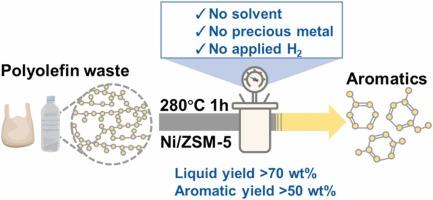Hydrogen-free upcycling of polyethylene waste to methylated aromatics over Ni/ZSM-5 under mild conditions
IF 12.2
1区 环境科学与生态学
Q1 ENGINEERING, ENVIRONMENTAL
引用次数: 0
Abstract
Upcycling waste plastic into aromatics presents an attractive strategy to tackle both plastic pollution and energy challenges. However, previous studies often rely on high temperatures, precious metals, and have broad product distributions. In this study, we reported that a Ni/ZSM-5 bifunctional catalyst can directly convert polyethylene (PE) into methylated aromatics with high selectivity under mild conditions, while eliminating the requirement for hydrogen gas and solvents. The liquid yield could attain up to 70.3 %, and the aromatics yield could achieve up to 51.7 %. Over 78.4 % of the aromatics were methylated aromatics including toluene, xylene, and mesitylene. Polymer chains underwent dehydrogenation over Ni and the acid sites in ZSM-5, forming C![]() C bonds. Certain of these bonds evolved into carbenium ions through the process of proton transfer at the acid sites. The optimization of Ni and acid sites enhanced the oligomerization, cyclization, and aromatization process. The extra mesopores created by Ni on the molecular sieve aid in the generation of aromatics. Furthermore, the Ni/ZSM-5 catalyst demonstrated the ability to convert typical commercial grades of PE plastic, such as gloves and bottles, into aromatics with a selectivity of up to 61.1 %. It offers an economically feasible and environmentally friendly upcycling avenue for the circular economy of plastics.
C bonds. Certain of these bonds evolved into carbenium ions through the process of proton transfer at the acid sites. The optimization of Ni and acid sites enhanced the oligomerization, cyclization, and aromatization process. The extra mesopores created by Ni on the molecular sieve aid in the generation of aromatics. Furthermore, the Ni/ZSM-5 catalyst demonstrated the ability to convert typical commercial grades of PE plastic, such as gloves and bottles, into aromatics with a selectivity of up to 61.1 %. It offers an economically feasible and environmentally friendly upcycling avenue for the circular economy of plastics.

在温和条件下,在 Ni/ZSM-5 上将聚乙烯废料无氢提升为甲基化芳烃
将废塑料升级再造为芳烃是解决塑料污染和能源挑战的一项极具吸引力的策略。然而,以往的研究通常依赖于高温和贵金属,而且产品分布广泛。在这项研究中,我们报道了一种 Ni/ZSM-5 双功能催化剂可在温和条件下直接将聚乙烯(PE)高选择性地转化为甲基化芳烃,同时无需氢气和溶剂。液体收率可达 70.3%,芳烃收率可达 51.7%。超过 78.4% 的芳烃为甲基化芳烃,包括甲苯、二甲苯和间二甲苯。聚合物链在镍和 ZSM-5 中的酸性位点上发生脱氢反应,形成 C=C 键。其中某些键通过酸性位点的质子转移过程演变成硒离子。镍和酸性位点的优化增强了低聚、环化和芳香化过程。镍在分子筛上产生的额外中孔有助于芳烃的生成。此外,Ni/ZSM-5 催化剂还能将典型的商业级聚乙烯塑料(如手套和瓶子)转化为芳烃,选择性高达 61.1%。它为塑料循环经济提供了一条经济可行且环保的升级再循环途径。
本文章由计算机程序翻译,如有差异,请以英文原文为准。
求助全文
约1分钟内获得全文
求助全文
来源期刊

Journal of Hazardous Materials
工程技术-工程:环境
CiteScore
25.40
自引率
5.90%
发文量
3059
审稿时长
58 days
期刊介绍:
The Journal of Hazardous Materials serves as a global platform for promoting cutting-edge research in the field of Environmental Science and Engineering. Our publication features a wide range of articles, including full-length research papers, review articles, and perspectives, with the aim of enhancing our understanding of the dangers and risks associated with various materials concerning public health and the environment. It is important to note that the term "environmental contaminants" refers specifically to substances that pose hazardous effects through contamination, while excluding those that do not have such impacts on the environment or human health. Moreover, we emphasize the distinction between wastes and hazardous materials in order to provide further clarity on the scope of the journal. We have a keen interest in exploring specific compounds and microbial agents that have adverse effects on the environment.
 求助内容:
求助内容: 应助结果提醒方式:
应助结果提醒方式:


